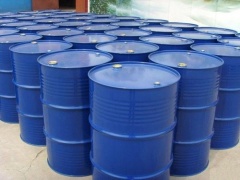Ethyleneglycol (MEG)
| Infobox on Ethyleneglycol (MEG) | |
|---|---|
| Example of Ethyleneglycol (MEG) |  |
| Facts | |
| Origin | - |
| Stowage factor (in m3/t) | - |
| Humidity / moisture | - |
| Ventilation | See text |
| Risk factors | See text |
Ethyleneglycol (MEG)
Contents
Description / Application
Ethylene glycol (IUPAC name: ethan-1,2-diol) is an organic compound widely used as an automotive antifreeze and a precursor to polymers. Ethylene glycol is toxic, and ingestion can result in death.
Ethylene glycol is not to be confused with diethylene glycol, a heavier ether diol, or with polyethylene glycol, a nontoxic polyether polymer.
Ethylene glycol is a colourless, practically odourless, low-volatility, low-viscosity, hygroscopic, syrupy, sweet-tasting liquid. It is completely miscible with water and many organic liquids. The hydroxyl groups on glycols undergo the usual alcohol chemistry, giving a wide variety of possible derivatives. Hydroxyls can be converted to aldehydes, alkyl halides, amines, azides, carboxylic acids, ethers, mercaptans, nitrate esters, nitriles, nitrite esters, organic esters, peroxides, phosphate esters and sulfate esters.
This chemistry permits ethylene glycol to act as an intermediate in a wide range of reactions. Especially significant is resin formation, including the condensation with dimethyl terephthalate or terephthalic acid resulting in a polyester resin.
The reactivity and solubility of ethylene glycol provide the basis for many applications. The widespread use of ethylene glycol as an antifreeze is based on its ability to lower the freezing point when mixed with water. The physical properties of ethylene glycol-water mixtures are therefore extremely important. The end uses for ethylene glycol are numerous
The major use of ethylene glycol is as a medium for convective heat transfer in, for example,cars and liquid cooled computers. Ethylene glycol is also commonly used in chilled water air conditioning systems that place either the chiller or air handlers outside, or systems that must cool below the freezing temperature of water. In geothermal heating/cooling systems, ethylene glycol is the liquid that transports heat through the use of a geothermal heat pump.
Due to its low freezing point ethylene glycol resists freezing. The freezing point of a mixture of 60% ethylene glycol and 40% water freezes below -45°C. It is used as a deicing fluid for windscreens and aircraft. Ethylene glycol breaks down in air in about ten days, and in water or soil in a few weeks. It enters the environment through the disposal of ethylene glycol-containing products, especially at airports where it is used in deicing agents for runways and airplanes.
In the plastics industry, ethylene glycol is important precursor to polyester fibers and resins. Polyethylene terephthalate, used to make plastic bottles for soft drinks, is prepared from ethylene glycol.
Use; coolant and antifreeze, asphalt-emulsion paints, heat-transfer agent, low –pressure laminates, brake fluids, glycol diacetate, polyester fibers and films, low-freezing dynamite, solvent, extractant for various purposes, solvent mixture for cellulose esters and ethers especially cellophane, cosmetics (up to 15%), lacquers, alkyd resins, printing inks, wood stains, adhesives, leather dyeing, textile processing, tobacco, ingredient of deicing fluid for airport runways, humectant, ball-point pen inks, foam stabilizer.
Shipment / Storage
Keep in a well-ventilated place. Empty containers may retain product residue. Store away from incompatible substances. Re-open used containers with caution. Containers which are opened must be carefully resealed and kept upright to prevent leakage. Keep away from oxidising agents and acids. Reacts violently with chlorosulfonic acid, oleum, sulfuric acid and perchloric acid.
Hazardous polymerisation does not occur.
| Flash point | 111°C., Flashpoint method: Closed up |
| Autoignition temperature | 398°C. |
| Upper flame limit (volume % in air) | 15.3 |
| Lower flame limit (volume % in air) | 3.2 |
| Boiling point | 198°C |
| Melting point | -12.9°C |
Risk factors
TLV: (vapour) ceiling 50 ppm. Toxic by ingestion and inhalation. Lethal dose reported to be 100 cc.
This product is a clear, odourless liquid. Not flammable. The product causes irritation of eyes, skin and mucous membranes. Harmful by inhalation, in contact with skin and if swallowed. May cause allergic skin reaction. Causes headache, drowsiness or other effects to the central nervous system. Swallowing large volumes of ethylene glycol can lead to kidney damage. Do not allow product to contact skin, eyes and clothing. Do not breathe vapours.
For overseas carriage aspects of Chemicals, the readers are recommended to acquire or have access to a good chemical dictionary, and a copy of the International Maritime Dangerous Goods (IMDG) Code, issued by the International Maritime Organisation. Also consult the applicable MSDS sheet.
Environmentally hazardous substance.











